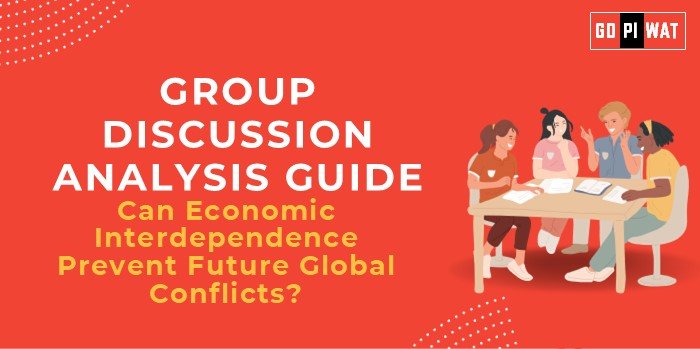📋 Group Discussion Analysis Guide: Can Economic Interdependence Prevent Future Global Conflicts?
🌐 Introduction to the Topic
- 📌 Opening Context: Globalization has led to unprecedented levels of economic interdependence among nations, raising debates about whether such ties can serve as a deterrent to armed conflicts in a volatile geopolitical landscape.
- 📖 Topic Background: The theory of economic interdependence suggests that intertwined economies discourage conflicts due to the high cost of disruption. Notable examples include the European Union’s peace-centric foundation post-World War II and modern-day Sino-American economic ties.
📊 Quick Facts and Key Statistics
🌍 Trade Growth: Global trade volume reached $32 trillion in 2022, showing deep economic interconnections (UNCTAD, 2023).
⚖️ Conflict Correlation: Nations with $500+ billion in annual trade flows have a lower likelihood of engaging in wars (World Bank Study, 2021).
🌐 EU Success Story: No wars among EU nations since its formation in 1957.
🇺🇸🇨🇳 US-China Trade: $690 billion in bilateral trade (2023) highlights mutual reliance despite political tensions.
💣 Defense Spending Surge: Global military spending crossed $2.2 trillion in 2023 (SIPRI), indicating persistent security concerns.
⚖️ Conflict Correlation: Nations with $500+ billion in annual trade flows have a lower likelihood of engaging in wars (World Bank Study, 2021).
🌐 EU Success Story: No wars among EU nations since its formation in 1957.
🇺🇸🇨🇳 US-China Trade: $690 billion in bilateral trade (2023) highlights mutual reliance despite political tensions.
💣 Defense Spending Surge: Global military spending crossed $2.2 trillion in 2023 (SIPRI), indicating persistent security concerns.
👥 Stakeholders and Their Roles
- 🏛️ National Governments: Craft trade policies and alliances influencing interdependence.
- 🌍 International Organizations: WTO and IMF promote cooperation and manage disputes.
- 📈 Private Sector: Multinational corporations drive globalization and shared economic stakes.
- 🌱 Civil Society: Advocates for peaceful resolutions through economic incentives.
🏆 Achievements and Challenges
✨ Achievements:
- 🇪🇺 European Union: A model for economic cooperation preventing conflicts.
- 🌏 ASEAN Stability: Strong intra-regional trade minimizes disputes in Southeast Asia.
- 🇺🇸🇨🇳 US-China Dependency: Reduces the risk of direct military conflict.
⚠️ Challenges:
- 🛡️ Nationalist Policies: Economic interdependence fails under nationalist policies (e.g., Brexit, US-China decoupling).
- ⚔️ Persistent Conflicts: Economic ties were insufficient deterrents in cases like Russia-Ukraine.
- 🔄 Over-Dependence: Creates vulnerabilities, such as supply chain disruptions (COVID-19 lessons).
🌍 Global Comparisons:
- ✔️ Success: EU demonstrates the strength of economic interdependence in preventing conflicts.
- ❌ Failure: Russia-Ukraine highlights the limits of economic reliance in deterring aggression.
Case Studies: The US-China trade relationship demonstrates cautious peace amidst strategic competition.
📢 Structured Arguments for Discussion
- ✅ Supporting Stance: “Economic interdependence fosters mutual reliance, making conflicts costly and undesirable.”
- ❌ Opposing Stance: “Economic ties are insufficient to prevent conflicts driven by ideology, territory, or sovereignty.”
- ⚖️ Balanced Perspective: “While economic interdependence reduces the likelihood of conflicts, it must be supplemented with robust diplomatic and security frameworks.”
🧠 Effective Discussion Approaches
- 🎯 Opening Approaches:
- Highlight the EU’s peace dividend as evidence of interdependence’s success.
- Use the Russia-Ukraine war to showcase the limits of economic reliance in preventing conflicts.
- Discuss the global trade increase as a deterrent to escalation in major conflicts.
- 🤝 Counter-Argument Handling:
- Counter claims of dependency risks with diversification strategies.
- Highlight historical instances where economic ties delayed rather than prevented wars.
📊 Strategic Analysis of Strengths and Weaknesses
- Strengths:
- Reduces incentives for war through mutual losses.
- Promotes collaboration on global issues (e.g., climate change, pandemics).
- Weaknesses:
- Vulnerable to policy shifts (e.g., trade wars, sanctions).
- Ignores non-economic drivers of conflict.
- 📈 Opportunities: Strengthen multilateral trade agreements; use interdependence to enforce global norms.
- ⚡ Threats: Economic nationalism disrupting globalization; over-dependence on critical partners leading to coercive tactics.
🎓 Connecting with B-School Applications
- 💼 Real-World Applications: Case studies in international business strategies and risk management for multinational corporations.
- 📚 Sample Interview Questions:
- “How can businesses navigate geopolitical risks tied to economic interdependence?”
- “Evaluate the role of supply chain diversification in reducing interdependence-related vulnerabilities.”
- 💡 Insights for B-School Students:
- Importance of economic risk assessment in global strategies.
- Role of economic ties in influencing international relations and policy.


